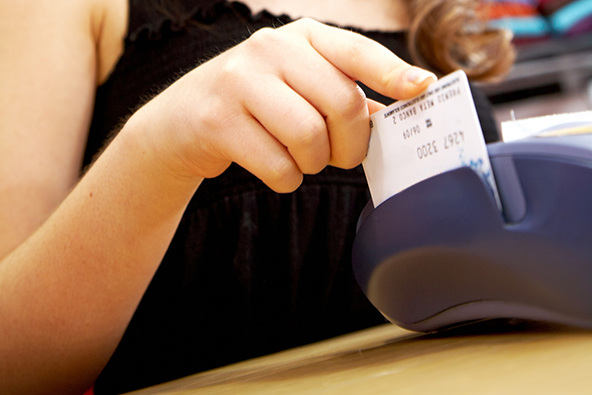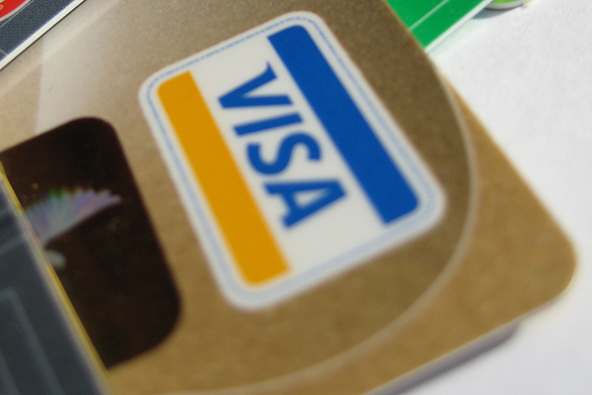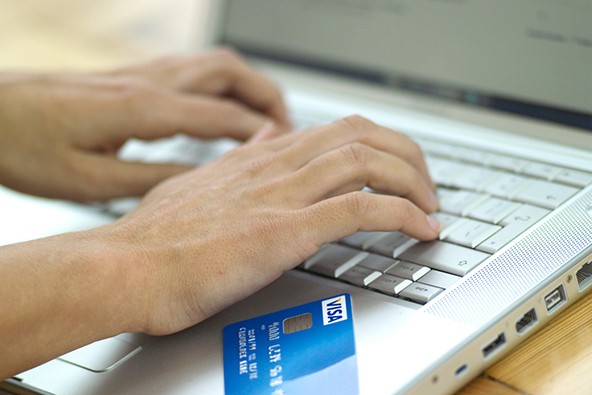Processing Card-Present Transactions

A face-to-face environment provides a much more secure way for accepting card payments than a non-face-to-face setting. As a result, brick-and-mortar businesses typically suffer from less fraud and chargebacks and pay lower transaction fees than e-commerce and direct marketing (MO / TO) merchants. Let’s take a look at the typical characteristics of a face-to-face transaction, what makes it safer and how to keep it that way.
Card-present transactions are those in which both the card and the cardholder are present at the time the payment is processed. Card-present merchants include grocery stores, department stores, fast-food restaurants, movie theaters, etc. Card acceptance settings where cardholders use unattended point-of-sale (POS) terminals, such as gas stations, are also defined as card-present transactions.
Visa and MasterCard require that merchants make all efforts to ensure that all card payments they accept are legitimate. This is in the merchant’s best interest as well, as fraud is costly, damages its reputation and, if unchecked, can lead to the suspension of the merchant account.
All card-present transactions are executed at a POS terminal. Whether you are experienced at the job or are new to it, if you follow a few simple card acceptance procedures, you will be sure to do it right every time a card is presented by a customer. A typical face-to-face card acceptance procedure goes through the following stages:
- Swipe the card. The first step in the payment acceptance process is swiping the card. Once the card is swiped, you should take it in your possession for the remainder of the transaction.
- Authorization. Authorizations are required before completing a card-present transaction in the following instances:
- The transaction amount exceeds your floor limit or the floor limit applicable to the transaction.
- The card is expired or not yet valid.
- The card is not signed.
- You wish to delay presenting the transaction record.
- The transaction receipt cannot be imprinted although the card is present.
- The terminal is unable to read the magnetic stripe or the chip (if one is present) on the card.
- The account number is listed on the Electronic Warning Bulletin or on the regional Warning Notice. If an account is listed in on the Electronic Warning Bulletin or regional Warning Notice, you must call your processor’s voice authorization center. You may be instructed to retain the card, which you should only do if it is safe to do so.
- The transaction is a recurring payment installment and a previous authorization request was declined by the card issuer.
- You are suspicious of the transaction for any reason. If the card or the cardholder looks suspicious, you must contact your processor’s voice authorization center and make a Code 10 call.
Listed in the table below are the possible responses to your authorization request and advice on how to proceed when you receive the response:Response
Explanation
Approved Issuer approves the transaction. This is the most common response — about 95% of all authorization requests are approved. Declined or Card Not Accepted Issuer does not approve the transaction. The transaction should not be completed. Return the card and instruct the cardholder to call the Issuer for more information on the status of the account. Call, Call Center, or Referrals Issuer needs more information before approving the sale. Most of these transactions are approved, but you should call your authorization center and follow whatever instructions you are given. In most cases, an authorization agent will ask to speak directly with the cardholder or will instruct you to check the cardholder’s identification. Pick Up Issuer wants to recover the card. Do not complete the transaction. Inform the customer that you have been instructed to keep the card, and ask for an alternative form of payment. If you feel uncomfortable, simply return the card to the cardholder. No Match The embossed account number on the front of the card does not match the account number encoded on the magnetic stripe. Swipe the card again and re-key the last four digits at the prompt. If a “No Match” response appears again, it means the card is counterfeit. If it can be done safely, keep the card in your possession, and make a Code 10 call. - Examine the card. While waiting for the authorization result, check the card’s security features to make sure it is authentic. Make sure that the card account, the expiration date and the card security code not been altered or tampered with and that the back of the card is signed.
- Customer signature. If the transaction is authorized, you should obtain the cardholder’s signature on the printed sales receipt. If the signature is missing, you may lose re-presentment rights if the transaction is charged back.
- Compare signatures. Compare the signature provided by the customer to the one on the back of the card and make sure they match. Also compare the account name and number printed on the receipt to the ones on the card.
- Return the card and receipt to your customer. If you are satisfied that the transaction is legitimate, return the receipt and the card to the cardholder, along with the purchased merchandise to complete the transaction.
- Make a Code 10 call. If you believe that a fraudulent activity is taking place, make a Code 10 call to your processor’s authorization center for instructions on how to proceed.
Image credit: Linnareacu.org.


